I’ve been bike commuting since I was a child, through rain, snow, heat waves, and the complete chaos of the pandemic. And I believe 2025 might be the best year yet to start commuting by bike.
Not because of the usual “save the planet” pitch you’ve heard a million times, but because the entire landscape has shifted in ways that make bike commuting more practical, more affordable, and frankly easier than ever.
Let me walk you through why thousands of people are discovering that two wheels beat four in ways they never expected.
The Post-Pandemic Reality Check
The pandemic completely rewrote the rules of commuting, and we’re still figuring out what that means. But here’s what I’ve noticed: the people who started bike commuting during lockdowns to grab a bit of extra fresh air aren’t going back to their cars. And there’s a reason for it.
Hybrid Work Changed Peoples Work-Life
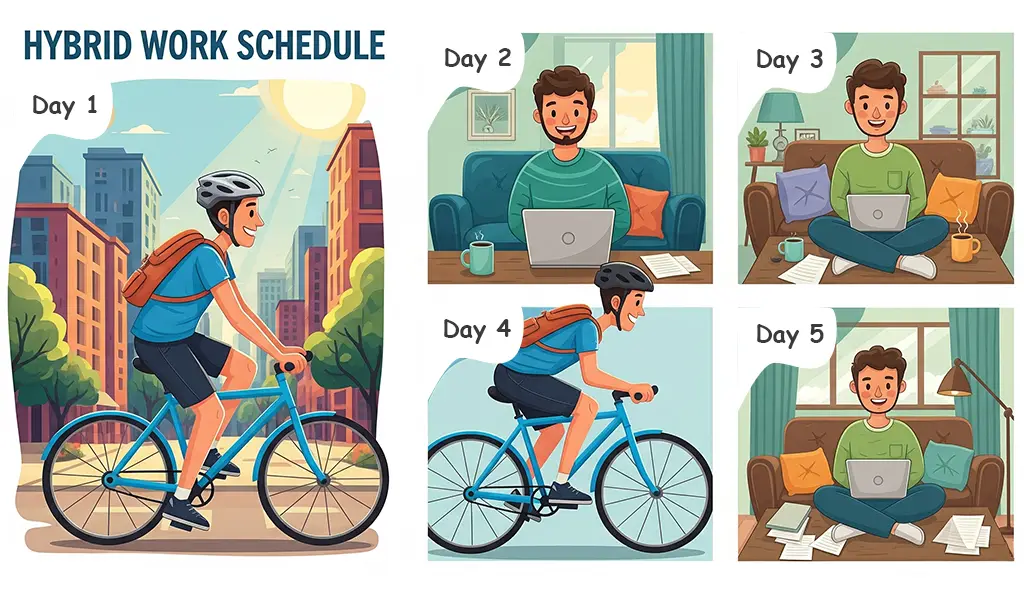
If you’re only going into the office 2-3 days a week, the math on car ownership gets really weird. You’re paying for insurance, registration, parking, and maintenance for a vehicle you may not be using as frequently. Meanwhile, that bike sitting in your garage could handle 90% of your transportation needs and you have friends or public transport for the last 10%.
I know people who sold their second car and bought a cargo bike instead. They’re saving thousands annually and actually enjoying their commute for the first time in years. When you’re not commuting every single day, that 45-minute bike ride becomes something to look forward to rather than something you must endure.
The Infrastructure Actually Improved
Cities used the pandemic as an excuse to finally build bike infrastructure they’d been talking about for decades. Protected bike lanes, bike parking at transit stations, and dedicated cycling routes appeared all over the country.
The result? Cycling feels a lot less sketchy these days than it did just a mere 5 years ago. I’m seeing people in business suits on bike share bikes, parents with kids in cargo bikes, and seniors on e-bikes. Showing that when the infrastructure is in place, the people will follow.
The E-Bike Revolution Changes Everything
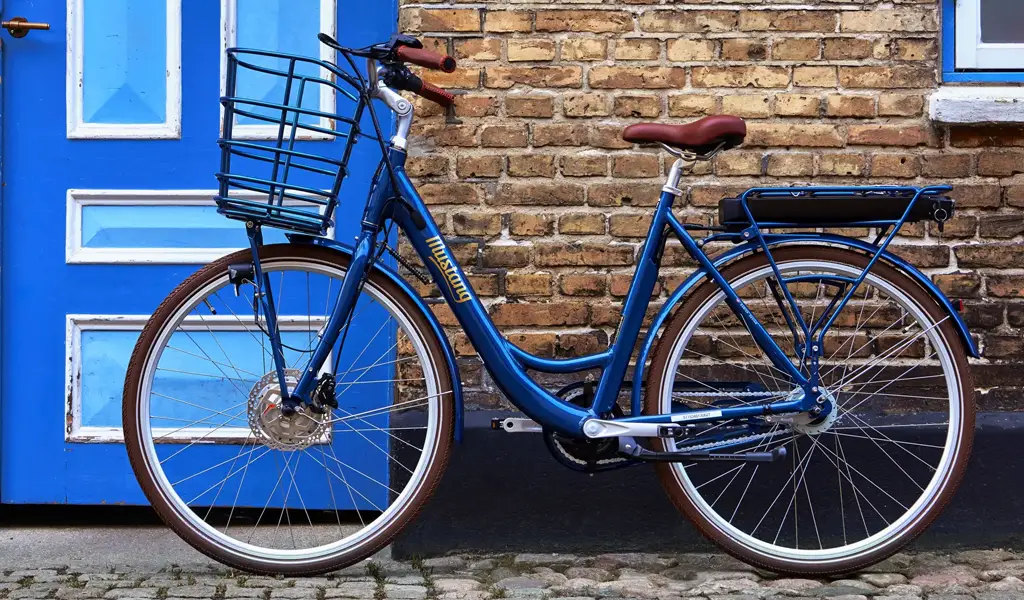
Let’s be honest – traditional bike commuting isn’t for everyone. Hills, headwinds, and arriving at work sweaty kept a lot of people away. The emergence of E-bikes solved all of that overnight.
Distance Is Much Less of A Barrier Anymore
I used to think 5 miles was about the limit for practical bike commuting, but as you grow stronger those 5 miles go by in a woosh. With an e-bike, 15 miles is a walk in the park. I know people doing 20-mile commutes daily who arrive less tired than when they drove the same route through traffic.
The range anxiety that plagued early e-bikes is gone too. Modern e-bikes get 40-60 miles of range, which covers most people’s round-trip commute with power to spare.
No More Arriving Drenched in Sweat
This sounds trivial until you realize it was the biggest barrier to bike commuting for most people. E-bikes let you ride at a comfortable pace without breaking a sweat, even on hills or in hot weather. You can wear normal clothes and arrive at work looking professional as ever.
I’ve watched friends who swore they’d never bike to work become daily e-bike commuters. The transformation is remarkable – they’re more energetic, less stressed, and actually excited about their commute. Who wouldn’t be if you’re zig-zagging your way through traffic effortlessly!
The Economics Make Sense Now
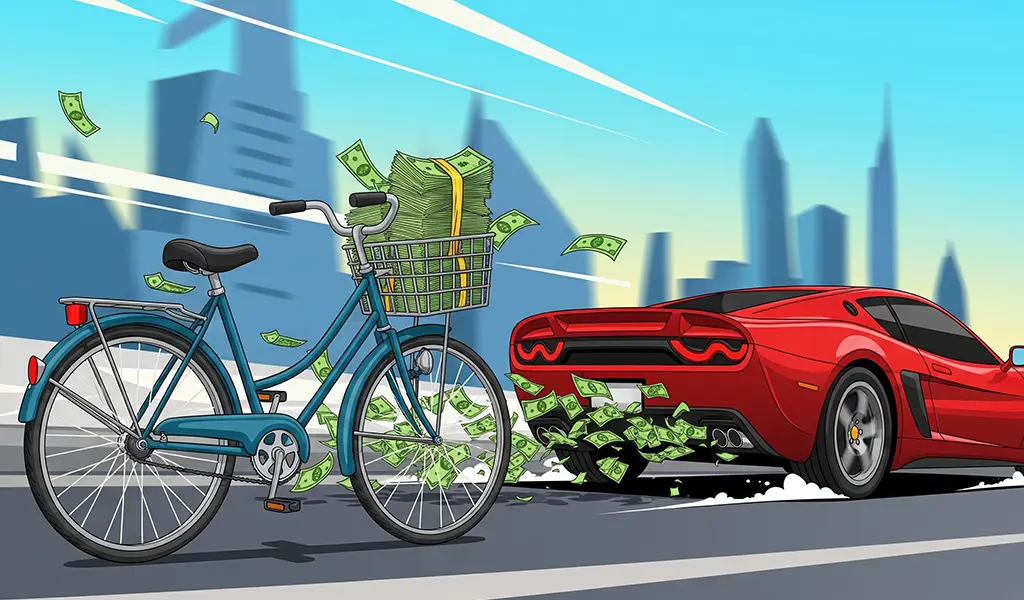
The financial case for bike commuting has never been stronger. It’s not just about gas money anymore – it’s about the entire cost of car ownership in an inflationary economy.
Car Costs Hit Breaking Point
Average car payments hit $700+ per month in 2024. Add insurance, parking, maintenance, and gas, and you’re looking at $1,200+ monthly just to own a car. For many people, that’s rent money.
Recent data shows regular e-bike users save upwards of £1,200 annually in transport costs, but my calculations and experience is that its far more than that. When you factor in avoided parking fees, reduced insurance costs, and eliminated car payments, the savings can be massive.
Government Incentives Are Real
There is a new bill called Bicycle Commuters Act of 2025 in the house that if passed, it will reinstate and increase the tax benefits of commuting by bike. It will also expand to cover e-bikes, scooters, and bikeshares.
Many states and cities offer additional rebates for e-bike purchases ranging from a few hundreds to thousand dollars depending on purchase. Some employers are also adding bike commuting benefits to their packages.
The Parking Economics
Downtown parking costs are insane. I know people paying $300+ monthly for parking spots. Others spend 20 minutes circling blocks looking for street parking. Bike parking is usually free and always more convenient than car parking.
The time savings alone are worth it. While car commuters are stuck in traffic or hunting for parking, bike commuters are already at their desks with a finished workout in their bag.
Mental Health and Productivity Benefits
This is where bike commuting really shines. Surveys dating all the way back to 2013 have consistently shown that people who bike to work are significantly happier with their commutes than everyone else, and it’s not even close. Who’s last? Public transit, no surprise there.
The Commute Becomes Your Gym Time
One of the bigger lifestyle changes is how people think about fitness. Gym memberships have gotten expensive, and many people are starting to realize they prefer outdoor exercise anyway. Bike commuting kills two birds with one stone. You get both your workout and your commute handled simultaneously.
Cycling improves cardio-vascular and aerobic fitness, lowers blood pressure, boosts energy, builds muscle, and improves coordination. But more importantly, you’re sneaking 20-60 minutes of exercise into your day without having to carve out separate time for the gym.
Lower Stress Levels
Traffic stress is a real health issue. Road rage, aggressive drivers, and constant stop-and-go traffic create chronic stress that affects sleep, relationships, and work performance. Bike commuting eliminates a lot of that stress.
Instead of fighting traffic, you’re getting fresh air, light exercise, and time to think. I’ve solved many complicated work-related problems and come up with plenty of content ideas during my rides. There’s something about the rhythm of pedaling that helps your brain process information differently.
Energy Levels Throughout the Day
Regular bike users report mental health benefits, reduced stress, and even fewer sick days. Win for you and your company. The morning exercise wakes you up naturally without caffeine dependence. The evening ride helps you decompress and transition from work mode to personal time.
Local Air Quality Matters
Even if I’m not a climate anxious person, local air quality does affect those in big cities. But not everyone can be like me and live far out from the city. Cities with more bike commuters have measurably cleaner air. When you bike to work, it can help cut down on harmful chemicals and pollutants like antifreeze and motor oil, and reduce emissions.
The health benefits extend beyond just the exercise. You’re contributing to cleaner air for everyone, including your own family and community.
The Social and Community Benefits
Bike commuting connects you to your community in ways that car commuting never could. You notice things, wave to people, and become part of the urban fabric instead of just passing through it.
You Actually See Your City
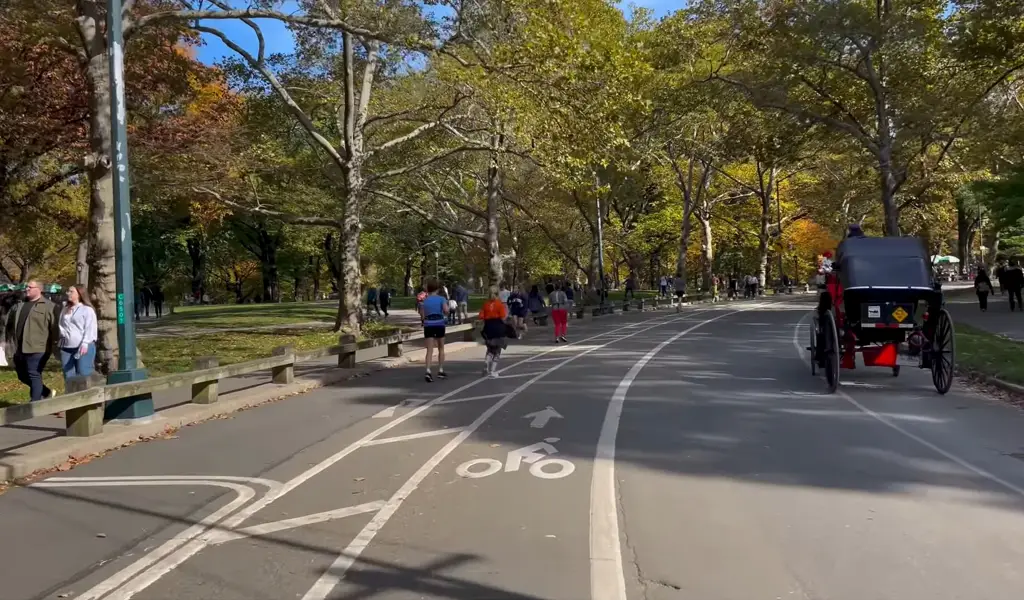
When you’re enclosed in a car, you miss everything interesting about your city. Bike commuting lets you discover neighborhoods, local businesses, and shortcuts you never knew existed.
The Cycling Community
There’s a genuine sense of community among bike commuters. We wave at each other, share route tips, and look out for each other’s safety. It’s a stark contrast to the isolation and aggression of car commuting.
Local cycling groups organize group rides, maintenance workshops, and advocacy efforts. Getting involved in cycling advocacy is one of the most effective ways to improve your city’s transportation infrastructure.
Practical Considerations
The practical barriers to bike commuting have gotten much easier to overcome. Better gear, improved infrastructure, and changing workplace norms have made it accessible to more people.
Weather Isn’t the Barrier It Used to Be
Modern cycling gear is incredibly effective. Waterproof jackets that breathe, lights that turn night into day, and clothing designed for temperature regulation make year-round commuting comfortable.
Many workplaces now have bike storage, showers, and changing facilities. Even if yours doesn’t, there are strategies for dealing with weather and arriving at work presentable.
Security and Theft Prevention
Bike theft is still a concern, but the solutions are better than ever. GPS trackers like find my device, better locks, and secure bike parking reduce the risk significantly. Many employers now offer secure bike storage as a benefit.
Insurance options for high-value bikes have improved too. Some homeowners and renters insurance policies cover bike theft, and specialized bike insurance is starting to reach acceptable levels of pricing.
Integration with Public Transit
Modern public transit systems are designed to work with bikes. Bike racks on buses, bike storage at train stations, and integrated payment systems make it easier to combine biking with public transit for longer commutes.
This hybrid approach extends your commuting range dramatically. You can bike to the train station, take transit for the long stretch, then bike from the station to your workplace. If they could just make public transportation a bit more pleasant we’re in for a good time.
The Technology Integration
Smartphones and cycling apps have made bike commuting much more convenient and safer. Real-time traffic updates, route optimization, and integration with fitness tracking create a seamless experience.
Navigation and Route Planning
Apps like Komoot and Strava provide bike-specific routing that considers traffic patterns, elevation changes, and road conditions. Real-time updates help you avoid construction zones and dangerous intersections.
Many cities now have official cycling apps that show bike lane locations, bike share availability, and real-time hazard reporting. The technology makes it easy to plan safe and efficient routes(LINK).
Safety Technology
Bike lights, reflective gear, and visibility technology are constantly evolving. Radar detectors like the Garmin Varia warn you about approaching cars. You have smart helmets with integrated lights and turn signals to increase visibility.
Making the Switch in 2025
If you’re considering jumping on the bike commuting wagon, 2025 is the perfect time to do it. The infrastructure is better and even smaller places are evolving rapidly, the technology has come a long way, and the economic incentives are stronger than ever.
Start Small and Build
You don’t need to commit to daily bike commuting immediately. Start with a day or two a week, or by doing some of your errands by bike. Many people haven’t been on a bicycle since childhood and they quickly remember those sweet childhood memories of joy and freedom as soon as they take their first few pedals in years.
The Investment Pays Off
A great commuter bike costs less than many people spend on car payments in two months. An e-bike costs less than a year of car ownership. The return on investment is immediate and continues for years. As long as you keep your trusted steed in good condition.
When you factor in health benefits, time savings, and reduced stress, bike commuting often pays for itself immediately by just making a good decision to invest in your future self. The long-term savings and health benefits make it one of the best investments you can make.
The Bottom Line
Bike commuting in 2025 isn’t about being a hardcore cyclist or making major lifestyle sacrifices. It’s all about recognizing that the way people get places has fundamentally changed, and bikes offer solutions to many problems that cars create.
The infrastructure is finally catching up to demand. The technology makes it safe and convenient. The economic aspect makes sense for more people than ever before. And the benefits to your overall health, and sanity, are clear as day.
Most importantly, bike commuting is highly joyful in ways that car commuting never was. Biking to work gets your body pumping and makes you happier, those two things alone are reason enough to try it.
The barriers that kept people away from bike commuting are disappearing. And the timing couldn’t be better.
If you’ve been thinking about bike commuting, 2025 is your year. Just test it, remember to give yourself some time to get into it, and discover why so many people are choosing two wheels over four. The worst that happens is you get some exercise and save some of those hard earned dollars. The best that happens is you completely transform your relationship with your work commute and your city.
The road is calling, and it’s time for you to answer!
-Tobias
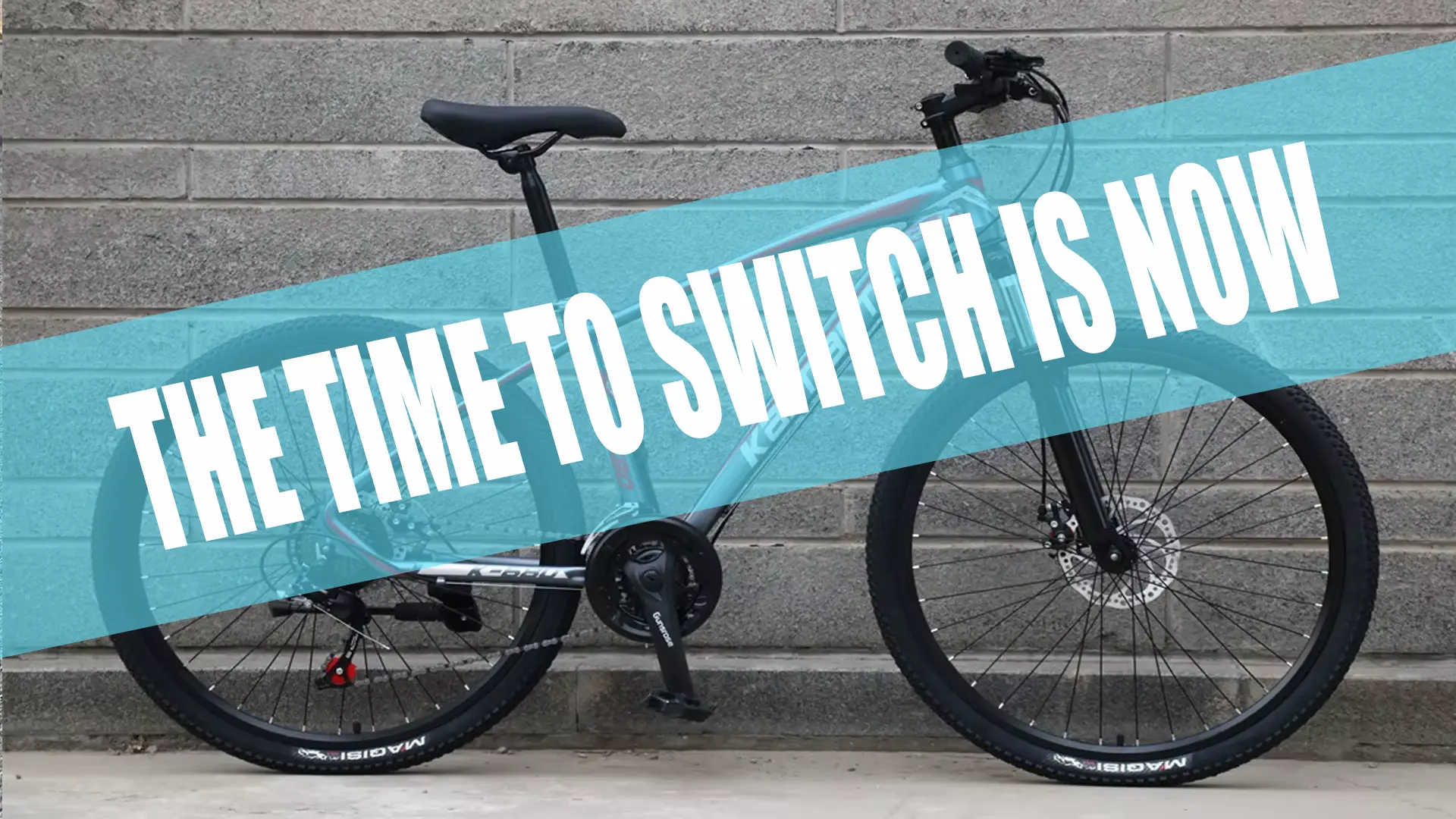
Leave a Reply